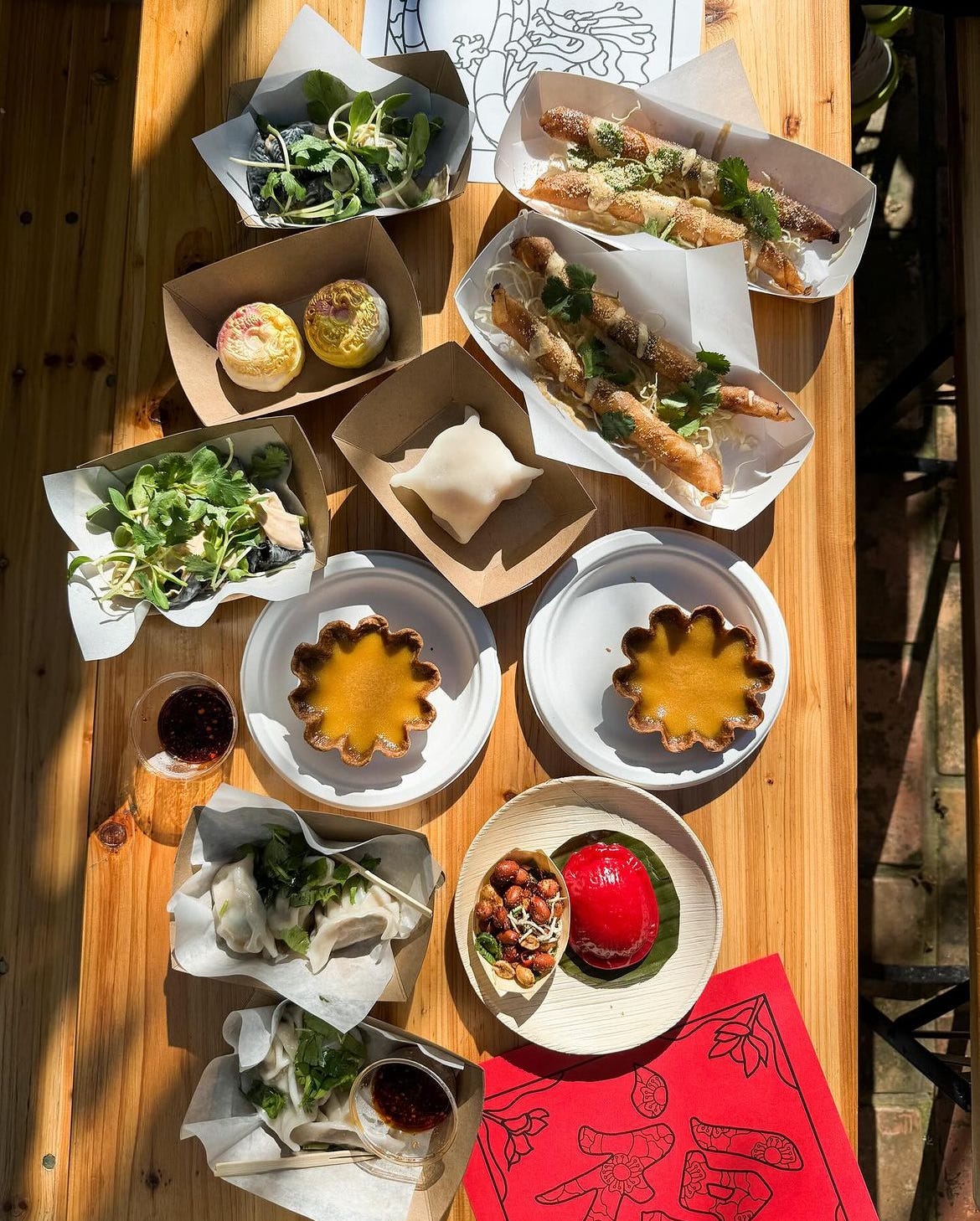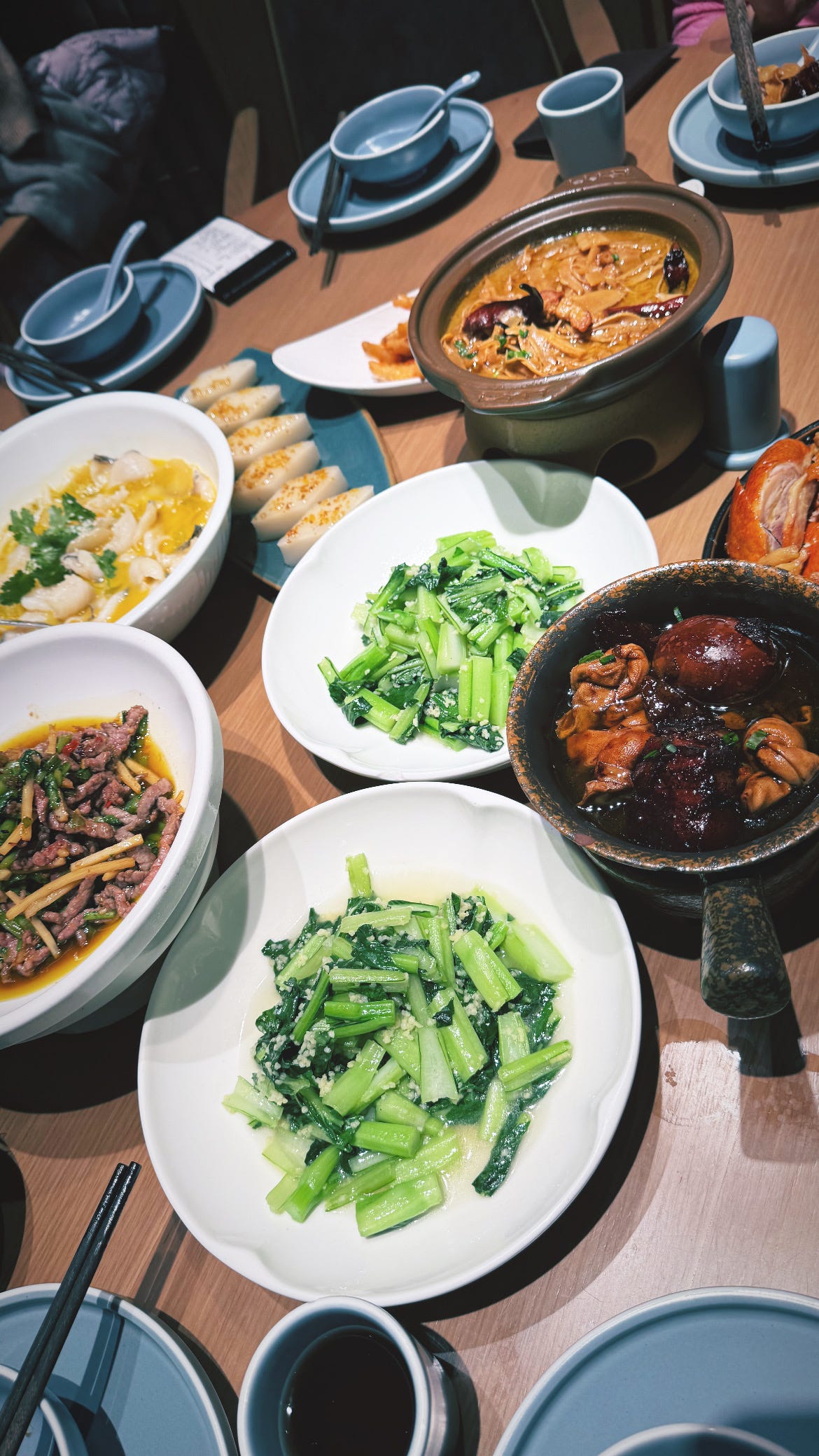Ushering in the Year of the Dragon
In this issue: food memories from our recent trip to China, my New Year resolution to just be regular, and a dumpling recipe so you can replicate Dumpling Club at home.
I had such a blast at our Lunar New Year celebration at Wave Collective on January 28th. Thank you to everyone who stopped by, both new faces and familiar ones!
In the days leading up to the event, while juggling all the myriad preparations that go into a combined art market and food pop-up, I kept thinking to myself, “What am I doing?! Why did I think this was a good idea? I’m not ready to be back out there!” But sometimes you just have to take a deep breath and jump into the fray. And once I saw all of your smiling faces in that insane line (gulp), I knew it was the right way to kick off the Year of the Dragon. ZERO regrets!
This issue of my newsletter includes: Part 2 of my Trip Diary (see Part 1 here); my New Year’s resolution AKA what I’m doing to recover from burnout; and a recipe for pork dumplings to help you celebrate Lunar New Year.
Leave a comment with any questions or feedback–you know I always love to hear from you.

TRIP DIARY, PART 2
In part 1 of my Asia trip diary, I wrote about my family and what it felt like to go home to Hangzhou and Linhai after 7 years away. But what about the food, you ask? WHAT. ABOUT. THE. FOOD.
We had so many spectacular meals in China, including towering seafood platters, innovative hot pot setups, and table-side hand-carved duck. But it’s the simpler things that make me nostalgic for home. Here are the top five “simple” things I loved from our trip…
#5 - tea eggs 茶叶蛋
We stayed at a lot of hotels during our trip and every one of them had an enormous breakfast buffet with a wide range of dishes. Chinese people take breakfast very seriously! In my home region, there’s a consistent set of staples found in every buffet: wonton soup, xifan 稀饭 (congee) with assorted toppings, steamed baozi 包子 (pork buns), doujiang 豆浆 (hot soy milk), noodles, and tea eggs. I love all these things and happily ate two tea eggs every day for the entire trip. As we were leaving Hangzhou, my aunt also made a batch of 22 eggs for us to take back to Shanghai–I think I ate at least ten of them. Well, not all at once…
#4 - wonton soup
In addition to the tea eggs, I ate a bowl of wonton soup every day that we were in China. Sometimes I had Shanghai small wonton 上海小馄饨, sometimes shepherd’s purse wonton 荠菜馄饨 and I also had local Linhai wontons in a thick brown soup. Once at the Grand Hyatt in Shanghai I had a truly terrible bowl of wontons. (That last one I refused to eat after the first bite, but the others were mostly decent.) The best bowl of wontons was the very first bowl I had after arriving in Shanghai, served in a dim sum restaurant in the Kerry Parkside Mall in Pudong. These were yet another variety of wontons called three delicacies 上海三鲜馄饨 filled with pork, shrimp and shiitake. It was the wrapper that did it for me: thin but substantial, perfectly chewy and perfectly cooked. Maybe I got lucky with the cook that day. The broth was also good, a classic Chinese clear broth–nearly colorless, yet so full of flavor–topped simply with zicai 紫菜 (Chinese seaweed) and omelet slivers. I could eat this every day for the rest of my life.
#3 - cooked greens
I’ve said it before and I will say it 1000 times more: cooked greens > raw greens in almost every scenario. But it seems only East Asians excel at cooked greens… (please, if you have examples to share, I would LOVE to be corrected on this) We had so many wonderful greens on this trip: the tenderest pea shoots stir fried with lotus seeds, garlic scapes with tarot, and a new-to-me dish of winged beans. Here we are at lunch in Hangzhou, where we ordered not one but two dishes of garlic stir-fried choy.
#2 - Mandarin oranges from Linhai
Before we even arrived in Linhai, my uncles had sent boxes brimming with Taizhou oranges to our hotel in Shanghai, and I do not exaggerate when I say these are the best mandarins I have ever had in my life. Each orange was encased in a thin peel, the flesh so sweet and juicy and not too acidic, and the aroma so fragrant, our fingertips smelled like fresh oranges for days. Growing up I was a picky eater (surprised?!) but I’d eat these by the bucket. I wish I knew the varietal (a quick Google search tells me they are probably huangyan mandarins 黄岩蜜橘) but I know my aunties buy them directly from the farm, the same day they are picked. Note: if reading this makes you crave local citrus, I suggest you check out my friends at fruitqueen who run a delectable local fruit delivery service in SF.
#1 - And finally… the humble roasted sweet potato!
Nowadays with the advent of IG and Tiktok, street food is so flashy. But growing up, what we bought off the streets was much simpler, like a bag of steamed buns or boiled peanuts. My favorite of all these is the charcoal-roasted sweet potato. When done well, the potato skin is dry and papery and slightly scorched, while the inside has a rich and creamy texture. All of the water has been cooked off so that the potato is sweet and intense, but somehow still moist. I bought one wrapped in foil from a vendor while walking around West Lake 西湖 in Hangzhou. Later in Shanghai, I had a craving and bought one from a 7-11 off the Bund (which needless to say was not as good). Apparently Lucas Sin has a hack to recreate this sweet potato at home… it did not work for me but you’re welcome to try. In the meantime, here’s a photo of my joy:
NEW YEAR RESOLUTION: BE REGULAR
Last week, when I showed up at ParksKitchen to teach a collaborate noodle class, chef/owner JiYoung exclaimed, “What did you do to your skin? You’re glowing!” And the answer is… nothing special. No updates to my facial routines (I continue to be a very loyal fan to Aesop Fabulous Face Oil), no spa treatments and no visits to the dermatologist (I’ve never been and I’m afraid to start!!).
But since closing our brick & mortar, I have made some changes. I’m prioritizing: 1) getting 7-8 hours of high quality sleep every night; 2) sitting down to eat three meals a day on a regular schedule; and 3) exercising 2-3 times a week, even if that’s just taking a long walk listening to a podcast.
The conventional advice to someone who is feeling burnt out is to take some “me-time”. Go get a massage! Take a few days off work! Plan a vacation! And I don’t disagree that getting away from it all is helpful to give your mind some breathing room. But in the last few months, I recognized that I was vastly underestimating the importance of regularity: regular sleep, regular meals, regular exercise. And that’s now my mantra for 2024. Just be regular!
If you’re feeling burnt out, I encourage you to try this for one week and see how you feel. Let me know what you think and if there’s something else “regular” you would add.
MY PORK DUMPLING RECIPE
Recently people have been asking for dumpling recipes to replicate Dumpling Club at home. While I’m holding my chili oil secrets close to heart, I’m happy to share my essential pork dumpling recipe. I originally published this on IG a few years ago and it’s still exactly how I make it. If it’s your first time mixing pork for dumplings, watch the video demo.
I’ve edited the original recipe for length and clarity, and included some instructions below for substituting kale with other vegetables like napa cabbage and spinach. Enjoy!
Pork + kale dumplings
This recipe makes enough dumpling filling for 50-60 dumplings.
For the pork, you’ll need:
1 lb ground pork, at least 20% fat - go for as high as 40% if your butcher can help you with a custom grind
2 Tbsp soy sauce
2 Tbsp Shaoxing rice wine (or sub sake)
1 tsp sesame oil
1 tsp salt
1 tsp sugar
1/4 cup water
For the veg, you’ll need:
1 lb of baby kale - I prefer Red Russian or Lacinato but any baby kale will do
1 oz (30g) of finely chopped herbs, like scallions, cilantro or Chinese chives (or a mix of all three!)
To make the filling:
First prepare the pork. In a large mixing bowl, add the rice wine, soy sauce, sesame oil, salt & sugar to the pork. Break up the pork until all liquid is absorbed.
Using your hand or a pair of chopsticks, whisk the meat in one direction until it becomes dense and sticky. When the pork feels hard to move, add a third of the water and continue mixing until absorbed. Repeat to use up the remaining water. Mix vigorously until the pork forms into a light and airy meatball. It should feel as if it has “bounce” to it. Total time spent actively mixing should be at least 5min.
Set aside the pork to rest, and prepare the kale. After washing thoroughly to remove any grit, blanch the kale for 10-15 seconds in boiling water. Shock in an ice bath, or run under cold water.
When the kale is cool to the touch, squeeze out as much water as you can. Place one or two handfuls into a clean dish towel, gather the ends and wring out excess water. Once you’ve removed as much water as possible, you should be left with approximately half a pound of kale. Finely chop.
Mix together the pork, kale and herbs. Optionally, cover and rest in the fridge overnight (marinating creates a subtle difference, but if you don’t have time, skip it). Fold using 1 Tbsp of filling per dumpling.
KALE SUBSTITUTIONS - remember, use one pound of raw vegetable to make roughly a half pound of finished, prepped vegetables:
Napa cabbage or green cabbage - separate the cabbage leaves, finely dice, and mix the diced cabbage with two teaspoons of salt. Let the cabbage sit for 10-15 minutes, then squeeze out all the excess water and add to pork mixture.
Bok choy - separate the leaves in each bunch of bok choy, wash thoroughly to remove grit and blanch as you would with kale. Finely dice, then squeeze out excess water and add to pork mixture.
Frozen chopped spinach - this is my favorite because it requires the least amount of work. Defrost one bag of frozen chopped spinach in cold water. Squeeze out all the excess water and add to pork mixture.
Shiitake mushrooms - whether using fresh or rehydrated mushrooms, at Dumpling club we always roast them first in olive oil and salt at 425F for 10 minutes. Resist the urge to immediately snack on the mushrooms. Dice and add to the mixture, using about 200g for 1 pound of pork.
Thanks for reading my latest Substack issue. If there are any topics or recipes you’d like to see in future newsletters, don’t be shy–leave a comment or email me!
xo Cathay






